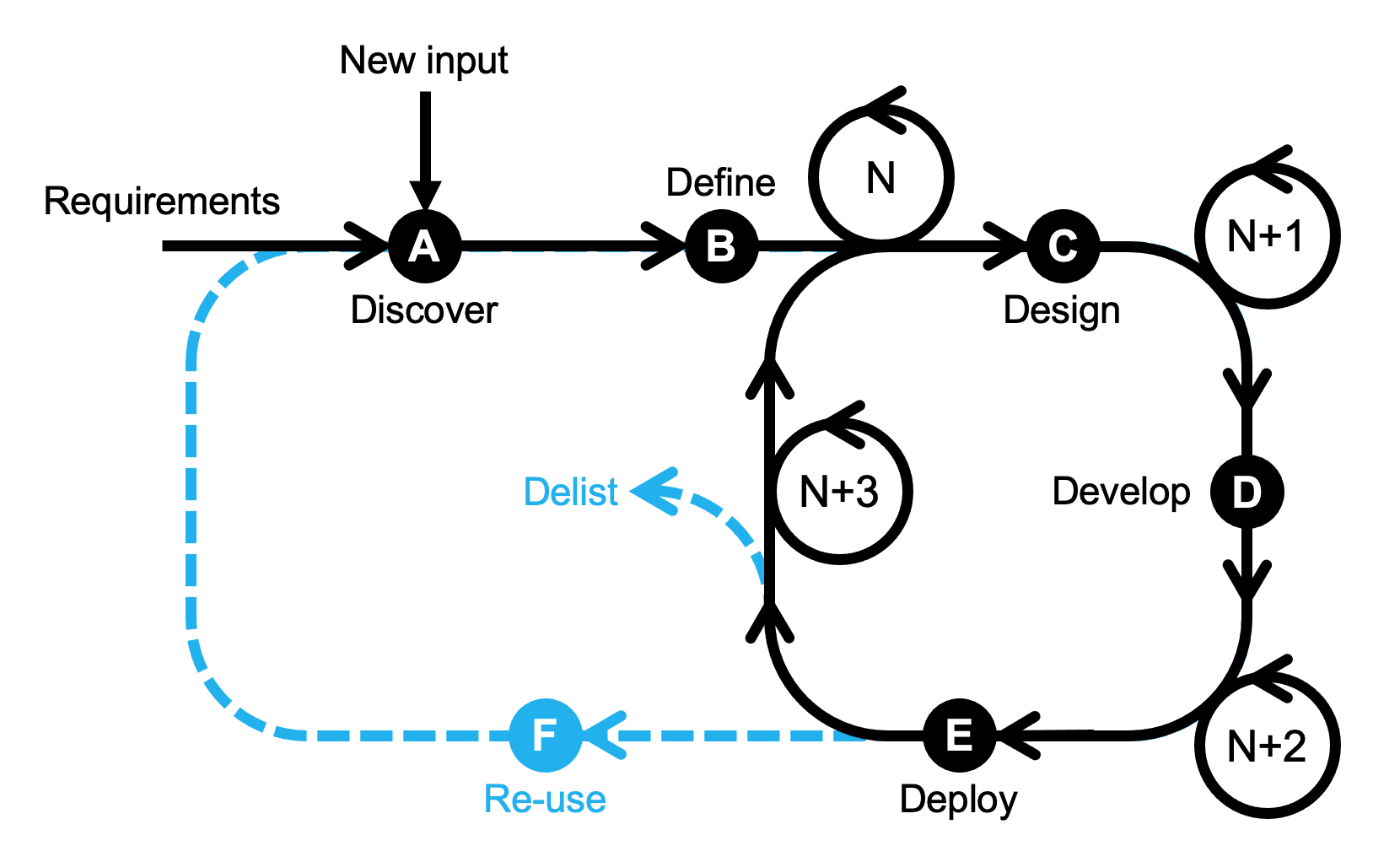Everything has a lifecycle
Everything goes through a lifecycle, starting with initiation, maturing, and ultimately becoming obsolete before getting either recycled or replaced by new versions. Each lifecycle operates within a particular and evolving context that lies between the stages of system development (where maturity increases from concept to industrialization) and system stability (where operations have matured, and the focus shifts to continuous improvement, maintenance, and performance optimization).
It often starts by looking at the basic lifecycle of a part, illustrated per the lifecycle states as shown in the figure below:

A lifecycle refers to a series of stages that a product, process, data set or activity goes through from its inception to its ultimate obsolescence and recycling or up-issuing into new versions. These stages occur within a specific and dynamic context between system development, which involves increasing maturity from concept to industrialization, and system stability, which involves mature operations, continuous performance improvement, and maintenance.
Maturity states are determined based on what is being developed, the ideation, collaboration, and review process, and can change forward or backward based on promotion and demotion decisions. The initial states are marked as concept (new) or work-in-progress, whereas the final states are released and obsolete.
In an industrial context, lifecycle states concern how data matures or changes over time and contributes to creating value as part of sustainable closed-loop systems.
Defining and understanding appropriate maturity gates helps in using tested and approved information or standards, reducing data duplication, and increasing collaboration and reuse across projects and teams.
Managing the lifecycle of things
Product-service-experience creation is a comprehensive set of disciplines that encompasses activities from concept to cradle, involving multiple domains and stakeholders. It involves creating products based on the principles of a circular economy, which prioritize positive holistic society-wide benefits over the traditional make-use-dispose cycle.
Lifecycle management extends to all aspects of a product's existence, including engineering, manufacturing, quality, sales and marketing, enterprise collaboration and management, maintenance and service, and all operations supporting the full enterprise digital chain. For instance, systems and sub-systems undergo new product introduction or development cycles (NPI and wider NPD processes), which include defining requirements, input, technological or product attributes, designing, developing, building, and operating / maintaining gates.

For successful integration and design of lifecycles across multiple aspects of enterprise operations, a comprehensive approach to business transformation and organizational change is necessary. This entails aligning talent, processes, data, and technology to a specific area of focus, such as product, application, asset performance, material intelligence, and more, and tracking their respective lifecycles through the digital thread across the enterprise.
Digital threadLifecycle management applies to all aspects of a product, including the technologies, processes, and data embedded in physical products, software applications, and asset performance. The management of talents, technologies, data, and processes (both internal and external services) also follow their respective lifecycles
Business model
Strategy
Value chain design / balanced scorecard / budgeting process / strategy map for internal and external operations
Structure
Organizational structure / skill and talent management / learning & development / sales & marketing / delivery and supportive functions
Operations
Revenue enhancement / cost reduction / profitability improvement / asset reduction / return on capital employed improvement / service delivery improvement
Transformation model
Strategic repositioning
Leadership alignment / business case / benefit realization management / stakeholder management / change management
Reorganization
Reskilling / customer value proposition improvement / education curriculum / talent acquisition / new functional teams
Value chain alignment
Make or buy strategy adjustment / outsourcing remix / ENVA improvement / NVA reduction / new capability introduction / RACI change
In every industry, data leads to knowledge, and ultimately to intellectual property and competitive advantage. There are plenty of opportunities to leverage data and convert it into value with the proliferation of connected devices, Big Data, inexpensive storage solutions, data mining and analytics tools to visualise and navigate to the required level of information.
Broadly speaking, data helps driving effective decisions:
Data consistency
How is data used in the engineering and product development space (upstream) vs in the manufacturing space (downstream)?
Data traceability
How does data quality and trust inform the decision making process, both upstream and downstream of the product development cycle?
Data model accessibility
Are data models, types and structures similar or different and, if different, how are decisions made in the respective areas?
Decision making process
What decisions are made upstream and downstream, and are they more data-driven or intuitive in one area and the other?
Decision model modularity
Considering that a lot of information flows downstream from engineering and product development to manufacturing, how much from the cascaded data is used downstream in the decision making process? In other words, do the decisions made downstream rely on data created (or authored / mastered) upstream?
The race to value generation in engineering research and development (upstream) is yet to catchup with the manufacturing domain (downstream) in terms of data-driven improvement opportunities. As a matter of fact, Industry 4.0, Industrial Internet of Things (IIoT) and connected machines are things that relate to manufacturing and assembly activities, mostly downstream of new product introduction activities—but also upstream as part of improvement research activities.
At Xlifecycle Ltd., we pride ourself in being direct and straightforward when defining and leading business change and data continuity improvement roadmaps. This is not only about mapping what does not work or what does not exist today, but about brainstorming and recommending what could-should be the way-forward to enhance business value.
Effective data drives product and process improvement opportunities
Digital continuityUnderstanding the business lifecycle and how people, products and services interact or interface is critical to improve the decision-making process and user experience, considering the relevant decisions required throughout successive lifecycle stages.
Customer feedback is great for telling you what you did wrong. It's terrible at telling you what you should do next.

